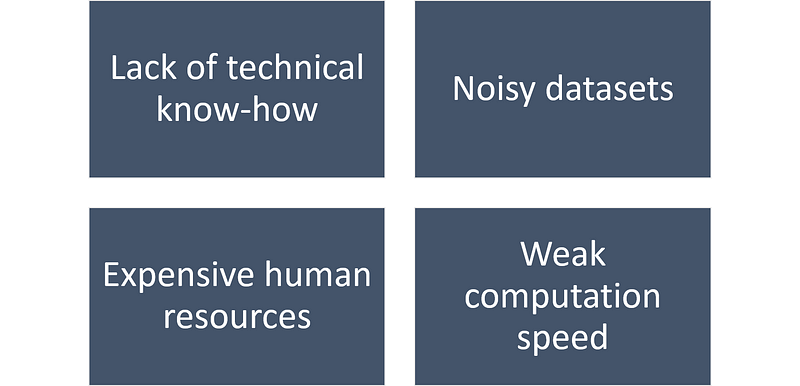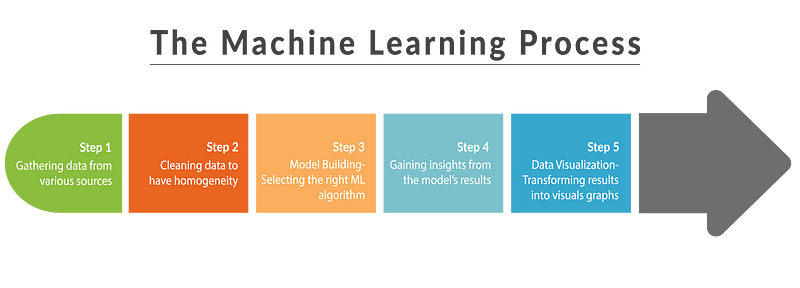Businesses are now overwhelmed with AI sales pitches promoting the technology’s potential to automate tasks, cut costs and improve performance.
Some of you are probably thinking about integrating an AI-based solution into your organization. Well, the good news is that you do not need to be an expert on AI, but you do need to understand the basics such as the importance of data(many articles are available for non-tech people on Medium). Once this is done, you can proceed to automate key tasks and use data to detect patterns and outcomes.
Before jumping into the AI bandwagon, please ask yourself these three questions:
- Is your task data driven?
- Do you have suitable and sufficient data to support an AI-driven solution?
- Do you have an understanding of how AI works?
Start small
It might be tempting to start your AI transformation by trying to completely reinvent your business process. However, this is the best way to fail. It is wiser to gain experience from smaller projects that will create a solid foundation to move onto bigger, more complex human interactions and AI challenges. Moreover, I recommend focussing on projects that have mature user cases with a proven ROI.
Try to avoid tasks with too many variables and potential outcomes.
In AI, it is better to focus on small parts of a process rather than the entire one. Given today’s capabilities., it is very difficult to replace a complete process with a single AI solution, designing such a system can be very hard. However, that same process can be broken down into smaller parts and some of those can be very easily automated.
Organizations should question whether the task they want to “automate” allows for repetition, and low cost of mistakes. The tasks that satisfy these specific criteria are excellent starting points for AI implementation.
Know exactly what you want
In many projects, I noticed that decision-makers do not have a clear vision of what their goal is with AI. Individuals can have different perspectives on the same problem and how to solve it. In the end, the lack of a clear vision can prevent full realization of benefits. My recommendation is to always spend time defining the goal. What are you trying to achieve and why?
You also need to have the right people part of the definition process. Indeed, it has to be a conversation between business decision-makers and data scientists that truly understand the business case and that can identify the right methodology and work with it best.
Indeed, your developers aren’t machine learning specialists. There is a difference between developers and data scientists. At the same time, you need to make sure that the AI will be easy-to-use and represent a long-term solution.
There are a lot of different ways to do machine learning, and the right solution is going to depend on a good understanding of the problem. If you lack the necessary human resources, I strongly recommend you to sollicitate the services of an AI specialized development agency. Indeed, working out what kind of AI is needed for different processes and whether these will be carried out in-house, outsourced or in partnership is an important step to developing a strategy.
If you decide to develop an AI solution within your organization, don’t forget that the learning curve is steep and the required resources to build your own can be very high. For example, a simple recognition model solution can be worth over 100K. It is worth it to have a look at the market for plug-and-play variants that piggyback on existing software services or platforms that are already familiar to companies. Most of the time, these solutions either require a few weeks of integration before they’re up and running.
After having established a clear definition of what the AI must achieve, you need to create a roadmap with deliverables. If you decide to outsource the development of an AI solution, it would be wise to have both a technical and business specialist (potentially an end-user) involved in the development process. Moreover, data scientists, data engineers, and operational systems engineers need to come together as a team to deliver a solution that can perfectly be used within your technical environment.
Furthermore, it is mandatory that your “AI solution has built-in feedback loops so that predictions and outputs from the AI can be corrected by those employees overseeing operations.” (source)
Finally, you need to build an interface to possibly interact with your new AI tool. In that context, it has to be easy-to-use, scalable and safe.
I recently worked for a company that wanted to develop an image recognition model to identify products in videos for marketing purposes. The AI did exactly what it was created to do. However, the company had issues with the solution because of the complex interface. It was basically made for technical users…
Best ways to fail an AI project
Based on my experience, most AI projects became issues because of the following elements:

In most AI projects, companies tend to ignore the human factor. Indeed, AI isn’t just about frameworks, data, and algorithms — it’s also about people. Your organization must have executive leadership support and the right talent in key AI roles. When it comes to development, I invite you to become familiar with the “Human in the loop” concept. This concept leverages both human and machine intelligence to create machine learning models. In this approach, humans are directly involved in training, tuning and testing data for a particular ML algorithm.
I noticed that successful projects always have one thing in common. The new AI deployment is always tested within a small group of employees who will provide you with honest feedback on the system’s interface.
3 ways to start an AI solution
For your AI needs, three basic options have emerged:
- Use an AI-SaaS solution such as Amazon AI (Rekognition), Google Cloud Vision or IBM Watson. They offer a narrow range of AI functions, mostly enabled via APIs for text and image recognition.
- Collaborate with third-party applied AI companies that specialize in a broader and more customized range of vertical AI services.
- Create your own machine learning system from scratch, using your own team and data. This is the most complicated option and is primarily for multinational companies or/and organizations where AI is essential to their core value and revenue.
(source)
I noticed that most companies I worked with, tend to start with the second solution. It is a good way to gain experience and don’t lose time against your competitors.
The Data issue
Most projects are based on Machine learning and it requires data… a lot of it. With enough decisions and data, patterns emerge that can be leveraged to make predictions for future decisions which is what companies mostly are looking for.
Before starting your AI journey, you have to make sure that your data from all the operational systems are pipelined and warehoused in a big data store for consumption by the AI solutions.
How much data do you need? It depends, but be prepared to have at least hundreds of examples of decisions and the factors that went into them.
Your data also needs to be labeled in a structured way — either fields in a system, database or a spreadsheet with rows and columns.
Labeled data: a group of samples that have been tagged with one or more labels. Labeling typically takes a set of unlabeled data and augments each piece of that unlabeled data with meaningful tags that are informative.
It can happen that an organization does not have enough labeled data. In that context, you need to start gathering the factors and decisions in a structured way, so that you can use it to feed the AI platform in the near future.
Another issue could be the dataset.
A data set (or dataset) is a collection of data.
Having the right dataset is crucial. However, the size of the dataset isn’t the real problem, it’s the scope. The challenge with AI is not so much with implementation; the big question is going to be how do you train the AI? That’s why you need to spend time to make sure your data is compatible with an AI solution.
In general, you need to modernize your data management technologies, simultaneously. Data is the foundation for successful AI strategies — ensure that your data integration, database, and data warehouses are ready to power your AI initiatives.

Moreover, you should invest in the infrastructure hardware required for your AI transformation. Machine learning requires a high level of computational power, as well as high-bandwidth and storage.
AI represents a fantastic opportunity for companies. However, it is easy to make mistakes since it is a new and complex technology. For instance, if you’re interested about solutions that somehow underestimate the importance of your business, ignore the data, are technology-orientated and that put promises before the problem, then it’s probably a bad solution for your organization. It is ket to take your time and don’t rush the AI development.



